9-2 Scientific Reasoning
A – Scientists and Children
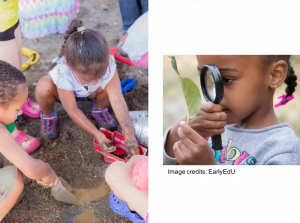
In many ways, scientists and children share the same job. They both are trying to figure out, to the best of their ability, just how the world works.
Scientists learn about the world by looking for patterns, asking questions, and doing experiments. They learn from their results and other scientists.
Children, like scientists, learn from others. They watch what others are doing and learn from watching the results, asking questions, and figuring out how others respond to their actions.
Scientific Process
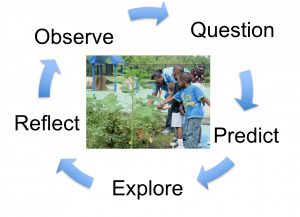
The scientific process has at least five parts:
- Observing the world through your senses
- Questioning why things are the way they are or how they work
- Predicting what will happen based on your theories of how the world works
- Exploring the world to either confirm or negate your predictions
- Reflecting on one’s findings to update or strengthen your theories
The Scientific Reasoning domain includes these five components across its two subdomains.
- The Scientific Inquiry subdomain includes observation and exploration.
- The Reasoning and Problem-Solving subdomain includes questioning, predicting, and reflecting, along with exploration through planned investigations.
Video: Salt Melts Ice (1:00)
In this video, Salt Melts Ice, we’ll see an educator guiding an experiment where children are using salt to melt ice. It is 1-minute long.
While watching the video, consider the following questions:
- What questions did the educator ask the children to encourage scientific inquiry?
- How did the educator guide children to notice similarities and differences?
- How did the educator encourage children to describe their observations?

Video Debrief
What questions did the educator ask the children to encourage scientific inquiry? (click to toggle expand or collapse)
Possible Answer
The educator asked:
— “What did you find out?”
— “What happened?”
— “Anything different?”
How did the educator guide children to notice similarities and differences? (click to toggle expand or collapse)
Possible Answer
The educator asked each child their opinion about whether one salt was different than the other.
How did the educator encourage children to describe their observations? (click to toggle expand or collapse)
Possible Answer
The educator modeled the use of different adjectives and asked each child for responses directly.
B – Scientific Inquiry
Cognitive Tools
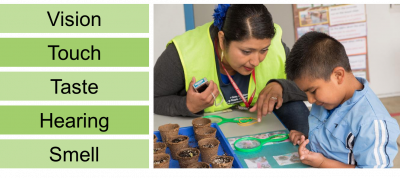
The subdomain Scientific Inquiry focuses on the development of children’s cognitive tools for observation and exploration.
These cognitive tools are children’s senses, such as vision, touch, taste, hearing, and smell, and their ability to describe their observations.
Tools include devices that help to extend the senses, such as binoculars or microscopes to enhance visual observations, or tools like microphones that allow us to amplify sound.
Children’s developing ability to describe their observations includes their growing use of adjectives and scientific talk to describe observations and inquiry processes.
Note that as children’s senses develop (for example, as their vision improves), they experience development in other areas, such as cognition, because they can see more of what is happening. In other words, growth in one area impacts development in other areas.
Using Adjectives
One way that children describe their observations of the world is through the use of adjectives.
By age 3, most children have a large repertoire of adjectives, but how they apply those adjectives can vary widely.
For example, researchers have found that 4-year-olds, but not 3-year-olds, can map new adjectives they hear onto new objects regardless of what kind of object it is. For example, if someone refers to a bumpy rhinoceros as a blickish rhinoceros and then asks for the blickish horse, 4-year-olds, but not 3-year-olds, would give them the bumpy horse.
Three-year-olds, on the other hand, can extend the new adjective between the same kinds of objects, for example, from a bumpy yellow horse to a bumpy purple horse.
Observing Attributes
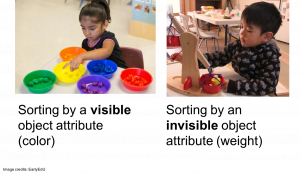
Another component of scientific inquiry is the use of observed attributes for categorization of objects. For example, children may match socks by color, design, or length.
While infants and toddlers sort objects using more obvious attributes, such as shape and color, older children begin to sort objects by less obvious attributes, such as sound, smell, texture, and function. These types of attributes require the development of more discerning cognitive tools for observation.
For example, you can see that the objects in the picture on the left can easily be sorted by color. The materials in the image on the right may all look the same but once explored can be sorted by weight. Some of them are heavier, and some are lighter.
Sorting by Invisible Attribute
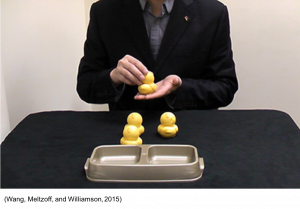
Scientists investigated 3- and 4-year-old children’s sorting by an invisible attribute.
In this study, 3- and 4-year-olds watched an adult play with four rubber ducks. The ducks all looked the same, but two were heavier than the other two. The children watched as the adult lifted each toy and moved it up and down with their hand as if weighing it. Then the adult placed the objects in one of two bins, sorting them into heavy and light piles.
Next, the adult gave the child a new set of identical, weighted toys. After watching the sorting demonstration, 4-year-olds, but not 3-year-olds, figured out there was an invisible property: weight.
When the 4-year-olds watched another person lift and weigh the objects, they used this information to figure out that the adult was sorting by an invisible property—weight.
As you can see from the previous few studies, a lot of development is occurring between the ages of 3 and 4. Playing math and science games and demonstrating new concepts at this time can help support children’s growing cognitive development.
C – Reasoning and Problem-Solving
Developing Scientific Abilities
The subdomain Reasoning and Problem-Solving focuses on children’s developing abilities to:
- Gather information.
- Make predictions.
- Plan investigations.
- Reflect and communicate their findings from their investigations.
If you think this sounds more like a description of a scientist than of a child, you’re not alone. The connection between the way scientists develop theories of the world and the way that children do has not been lost on cognitive researchers.
As we mentioned at the beginning of this section on the domain Scientific Reasoning, the view of the child as a young scientist has motivated many studies on children’s developing scientific abilities.
Testing Theories
When children observe events in the world, they begin to form theories of how and why those events are taking place.
As we discussed in the last session, even infants will test their observations of the world. For example, do you remember the infants who dropped the toy that was observed to defy gravity? Those infants were testing their theory that objects drop when not supported.
As children’s observational skills and physical abilities develop, they are able to form and test a wider variety of theories.
Cause and Effect
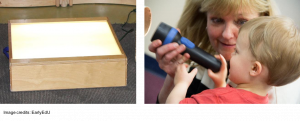
For example, children are increasingly curious about why cause and effect does not work 100 percent of the time.
Researchers used children’s curiosity to explore children’s ability to figure out complex causal relationships.
Children watched two experimenters. One researcher played with a light-up box, while the other watched. Some children saw that person successfully light up the box several times. Other children, however, saw that the other person was only successful about a quarter of the time.
Then, the experimenter, who was successful only a quarter of the time, revealed to the children that there was a flashlight under the table. To children, the flashlight could be a way of preventing the box from lighting up.
And that is what the researchers found. When given a turn to play with the box, children who saw the box work only some of the time tried turning the flashlight on and off as a way to control whether it worked or not.
Children who saw the box always work, however, did not think of the flashlight as a potential cause since the box worked perfectly. To these children, the flashlight just seemed like a random extra detail.
Essentially, what children figured out was that if the box wasn’t working 100 percent of the time, something must be making it not work some of the time. Since they didn’t know what the flashlight could do, they figured it might be what was making the box not work some of the time.
Children as young as 4 years old can reason about invisible causes by just observing a series of events.
D – Using Scientific Inquiry
Process of Scientific Inquiry
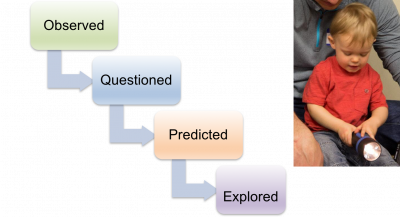
The children in this study, therefore, used the process of scientific inquiry to explore observed events. Children:
- First used their vision to observe the box’s operation and the experimenter’s use of a flashlight.
- Questioned why the box didn’t work some of the time for the other person.
- Predicted that the flashlight might have some control over the box.
- Explored that possibility by playing with the flashlight when they got a turn to play with the box.
Choosing Confusing Toys
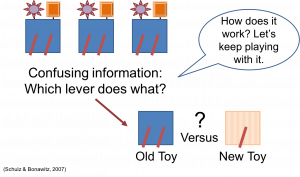
Scientists have even shown that when children are playing, they may sometimes be performing investigations about how things work.
For example, children are more likely to play with objects that are confusing than ones that they already understand. This suggests that they are motivated to play to learn new things.
Children ages 4 to 5 years old were shown a toy with two levers. When both levers were pushed, a small light and toy popped up from the top of the box.
Since both levers were always pushed at the same time, there was no way to know how the levers worked. Did one lever control the light and the other the toy? Or did they both have to be pushed to make both toys come out of the box?
In fact, children were so curious about how the toy worked that they would choose to play with the toy they had already seen but didn’t understand instead of playing with a completely new toy.
You may see the children you work with doing similar things. They may prefer to play with toys that are new or that they don’t understand yet instead of toys that they know very well or that are very simple.
Vroom Tip
Check out this Vroom tip to get more ideas about how to investigate and talk about science with young children.
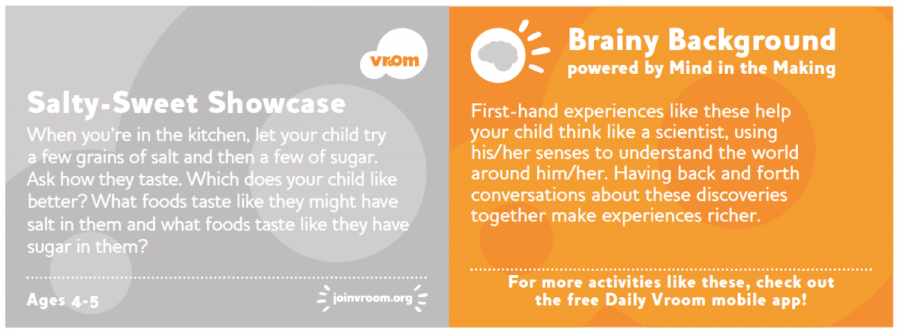
View text-only alternative of this Vroom card
Salty Sweet Showcase
When you’re in the kitchen, let your child try a few grains of salt and then a few of sugar. Ask how they taste. Which does your child like better? What foods taste like they might have salt in them and what foods taste like they have sugar in them?
Ages 4-5
Brainy Background powered by Mind in the Making
First-hand experiences like these help your child think like a scientist, using his/her senses to understand the world around him/her. Having back and forth conversations about these discoveries together make experiences richer.
Does this tip make sense in the context of an early learning environment? And if not, how might you adapt the activity to better fit that environment?
 References
References
Cultivate Learning (Producer). (2017). Salt melts ice. University of Washington. [Video File]
Klibanoff, R., & Waxman, S. (2000). Basic level object categories support the acquisition of novel adjectives: Evidence from preschool-aged children. Child Development, 71(3), 649-659.
Schulz, L., & Sommerville, J. (2006). God does not play dice: Causal determinism and preschooler’s causal inferences. Child Development, 77(2), 427-442.
Schulz, L. E., & Bonawitz, E. B. (2007). Serious fun: Preschoolers engage in more exploratory play when evidence is confounded. Developmental Psychology, 43(4), 1045-1050.
Stahl, A., & Feigenson, L. (2015). Observing the unexpected enhances infants’ learning and exploration. Science, 348(6230), 91-94.
Vroom. (n.d). Vroom tips. [PDF].
Wang, Z., Meltzoff, A.N., & Williamson, R. (2015). Social learning promotes understanding of the physical world: Preschool children’s imitation of weight sorting. Journal of Experimental Child Psychology, 136, 82-91.
EarlyEdU Alliance (Publisher). (2018). 9-2 Scientific reasoning. In Child Development: Brain Building Course Book. University of Washington. [UW Pressbooks]

